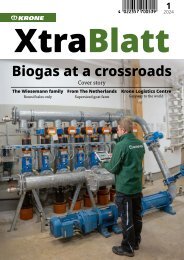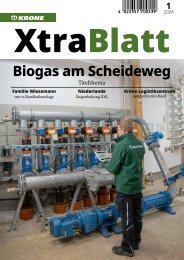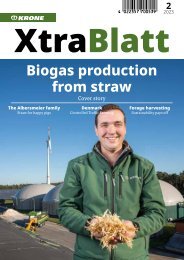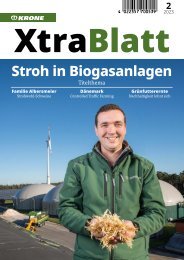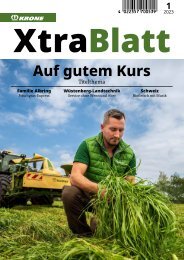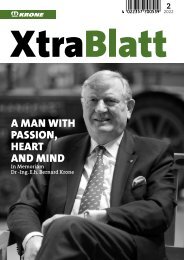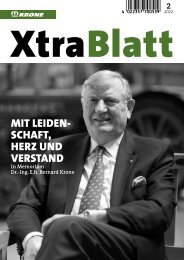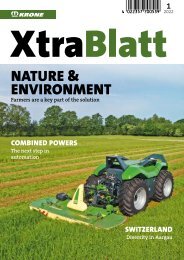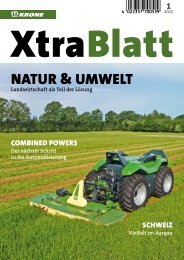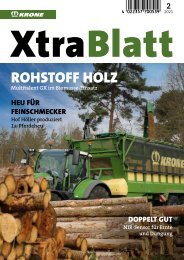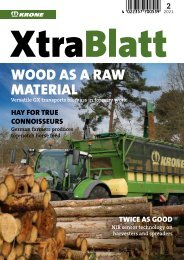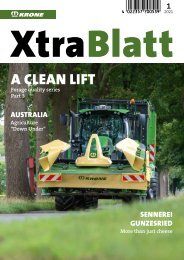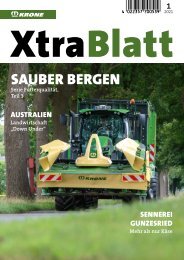XtraBlatt Issue 01-2023
You also want an ePaper? Increase the reach of your titles
YUMPU automatically turns print PDFs into web optimized ePapers that Google loves.
HASI STRAHM, MÜNCHENBUCHSEE, SWITZERLAND<br />
Organic meat<br />
with music<br />
Broad, black-tipped horns, dark eyes, dark muzzle – Swiss<br />
organic farmer Hasi Strahm loves his Aubrac cattle.<br />
He markets the meat himself under the brand stressfrei<br />
(stress-free). A farm walk.<br />
Swiss organic farmer Hasi<br />
Strahm farms a 65-head herd<br />
of Aubrac cattle, including 25<br />
suckler cows.<br />
Hasi Strahm lives and works by the maxim “nature<br />
pure and simple, with modern technology.”<br />
A<br />
s we enter a generously sized shed on<br />
Hasi’s farm in the Swiss canton of Bern,<br />
we find more than 60 Aubrac cattle<br />
mingling in their extensive straw-filled<br />
stall which is open to the south. On the north side<br />
are two hay and straw storage bays, each measuring<br />
800m³, machinery sheds, and a recreation<br />
room with kitchen on a mezzanine level. Beneath<br />
this is the farm’s meat processing room, along<br />
with a cold store. The rails of an overhead hay<br />
crane traverse the shed roughly 10m above us.<br />
Sixty-three-year-old Hasi Strahm steps down from<br />
the cab after delivering a load of fresh hay to the<br />
feeding platform.<br />
29-year-old Hasi Strahm first set about converting<br />
the conventional dairy operation to organic milk<br />
production – to Bio Suisse standards. “In 2006 I<br />
gave up farming Holstein cows,” he says. “I was<br />
keen to switch to a suckler herd, with a robust<br />
breed that was resistant and long-lived. My wish<br />
was and still is to produce organic meat – under<br />
the maxim: nature pure and simple, with modern<br />
technology.”<br />
Healthy cattle<br />
His search for a suitable breed took him to a beef<br />
farm in northern Germany. He was very taken<br />
with the Aubrac cattle they bred there – medium-framed,<br />
well-muscled, with a yellow to reddish-brown<br />
coat. “And that’s still the case today,” he<br />
says, his eyes lighting up as he proudly approaches<br />
a cow contentedly munching on hay. He scratches<br />
its head affectionately before moving on. “I now<br />
breed them myself, but when it comes to the herd<br />
book, I’m something of a minimalist. For example,<br />
I don’t weigh these animals.” He replaces the bull<br />
every four years. “I make a point of breeding<br />
only healthy animals with true characteristics,”<br />
he says. Apart from the bull, he doesn’t bring in<br />
any animals from outside. “In this way, I avoid<br />
introducing parasites and disease.” The livestock<br />
farmer is happy: “My animals are 99% healthy,” he<br />
adds with satisfaction.<br />
The Hasi Farm is<br />
situated in the Swiss<br />
canton of Bern at<br />
560m above sea level.<br />
The scenic location<br />
offers views of the<br />
Alps and the Jura<br />
When I built<br />
this livestock<br />
shed<br />
eight years<br />
ago, I was<br />
fulfilling a<br />
long-held<br />
dream.<br />
Hasi Strahm<br />
The 63-year old farmer tells his story: “When I built<br />
this livestock shed eight years ago, I was fulfilling<br />
a long-held dream. The building is designed to<br />
make work as simple as possible. You see, I run<br />
the farm on my own just now.” He began farming<br />
Aubrac cattle in 2006 – starting with seven suckler<br />
cows and one bull. “I now have 25 suckler cows in<br />
my herd,” he says.<br />
The seasoned farmer took over the farm from his<br />
parents 33 years ago. At the time, it was still in the<br />
middle of Münchenbuchsee, a small town which<br />
now has a population of well over 10,000. The then<br />
Originally, his farm was situated on land that was<br />
designated for building. So, he sold it in 2<strong>01</strong>2 and<br />
relocated the farm 2km further into the countryside<br />
– purchasing the necessary land and constructing<br />
the buildings in the process. “Ultimately,<br />
this project has cost me around 9 million Swiss<br />
Francs, but I’m an idealist,” Hasi Strahm concedes.<br />
“Anyway, two of my children will take over the farm<br />
in the next few years. So if everything goes to plan,<br />
the project has a wonderful future.”<br />
26 1|<strong>2023</strong> <strong>XtraBlatt</strong><br />
<strong>XtraBlatt</strong> 1|<strong>2023</strong><br />
27



